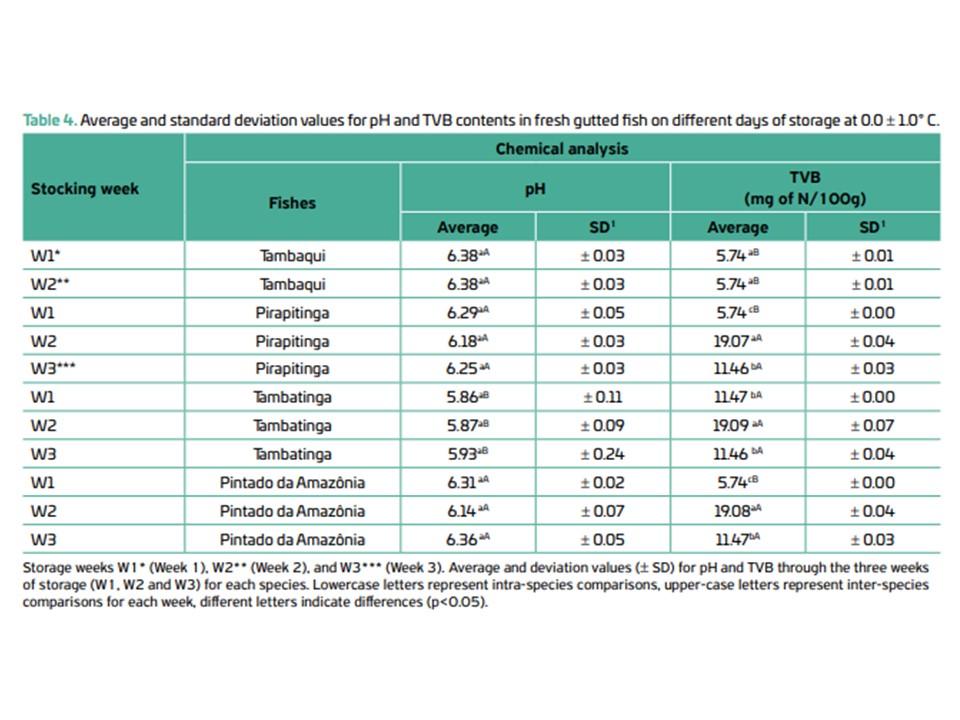Quality assessment of amazonian fish from fish farming stored on ice
DOI:
https://doi.org/10.21708/avb.2022.16.2.10492Resumo
The cultivation of natives Amazonian fish such as tambaqui (Colossoma macropomum), pirapitinga (Piaractus brachypomus), tambatinga (female, Colossoma macropomum X Piaractus brachypomus, male) and Pintando da Amazônia (female, Pseudoplatystoma sp. X Leiarius marmoratus, male) temmoratus, increased in recent years, making studies related to the validity of these foods after processing necessary. Therefore, the aimed of the study was to evaluate the sensory, microbiological (Staphylococcus coagulase positive count and presence of Salmonella spp.) and chemical (pH and Total Volatile Bases (TVB) quality of fresh gutted fish stored on ice. Nine specimens of each species were used, all cultivated in an excavated tanks. The fasting time ranged from 16 to 48 hours, depending on the species, the fish was slaughtered by means of cold shock. The fish was gutted and stored in the fish fridge. Sensory analysis was performed by a trained team available. For other analyses, it was sent to a laboratory specializing in food analysis. The sensory analysis of fresh eviscerated tambaqui was characteristic of the species until the 15th day of storage. Fresh eviscerated pirapitinga presented until the 16th day. The fresh eviscerated tambatinga hybrid was kept until the 14th day of storage. And for the Pintado da Amazônia, the organoleptic characteristics were presentable until the 12th day of storage. The microbiological and physical-chemical analyzes were in accordance with Brazilian legislation in all specimens of the analyzed species. It was observed that the longer the fasting period, there was a numerical increase in the pH of the fish meat.
Downloads

Downloads
Publicado
Edição
Seção
Licença
Copyright (c) 2022 Acta Veterinaria Brasilica

Este trabalho está licenciado sob uma licença Creative Commons Attribution 4.0 International License.
Autores que publicam na Acta Veterinaria Brasilica concordam com os seguintes termos: a) Autores mantém os direitos autorais e concedem à revista o direito de primeira publicação, com o trabalho simultaneamente licenciado sob a Licença Creative Commons Attribution que permite o compartilhamento do trabalho com reconhecimento da autoria e publicação inicial nesta revista. b) Autores têm autorização para assumir contratos adicionais separadamente, para distribuição não-exclusiva da versão do trabalho publicada nesta revista (ex.: publicar em repositório institucional ou como capítulo de livro), com reconhecimento de autoria e publicação inicial nesta revista. c) Autores têm permissão e são estimulados a publicar e distribuir seu trabalho online (ex.: em repositórios institucionais ou na sua página pessoal) a qualquer ponto antes ou durante o processo editorial, já que isso pode gerar alterações produtivas, bem como aumentar o impacto e a citação do trabalho publicado (Veja O Efeito do Acesso Livre).


 Esta obra está licenciada com uma Licença
Esta obra está licenciada com uma Licença 